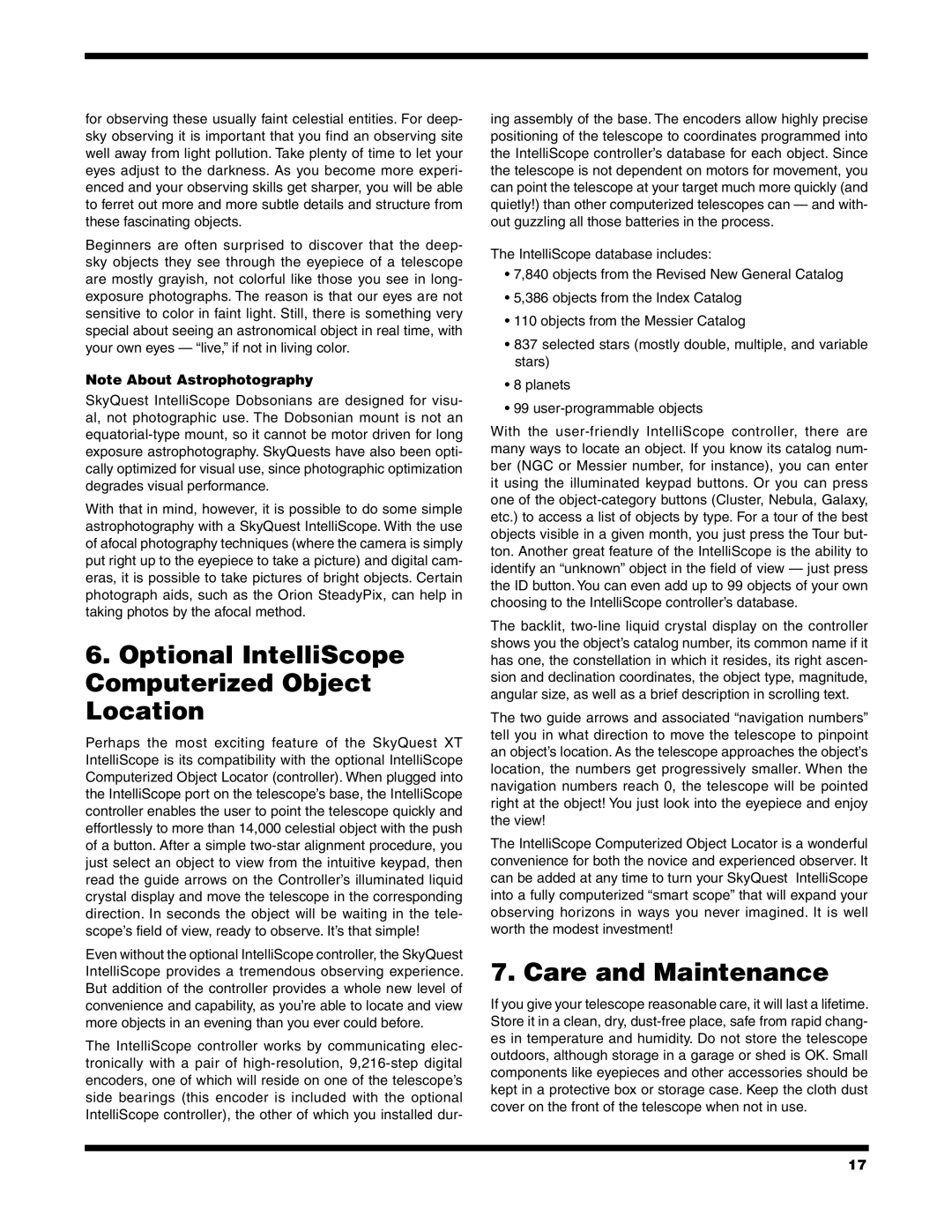
for observing these usually faint celestial entities. For deep- sky observing it is important that you find an observing site well away from light pollution. Take plenty of time to let your eyes adjust to the darkness. As you become more experi- enced and your observing skills get sharper, you will be able to ferret out more and more subtle details and structure from these fascinating objects.
Beginners are often surprised to discover that the deep- sky objects they see through the eyepiece of a telescope are mostly grayish, not colorful like those you see in long- exposure photographs. The reason is that our eyes are not sensitive to color in faint light. Still, there is something very special about seeing an astronomical object in real time, with your own eyes — “live,” if not in living color.
Note About Astrophotography
SkyQuest IntelliScope Dobsonians are designed for visu- al, not photographic use. The Dobsonian mount is not an
With that in mind, however, it is possible to do some simple astrophotography with a SkyQuest IntelliScope. With the use of afocal photography techniques (where the camera is simply put right up to the eyepiece to take a picture) and digital cam- eras, it is possible to take pictures of bright objects. Certain photograph aids, such as the Orion SteadyPix, can help in taking photos by the afocal method.
6.Optional IntelliScope Computerized Object Location
Perhaps the most exciting feature of the SkyQuest XT IntelliScope is its compatibility with the optional IntelliScope Computerized Object Locator (controller). When plugged into the IntelliScope port on the telescope’s base, the IntelliScope controller enables the user to point the telescope quickly and effortlessly to more than 14,000 celestial object with the push of a button. After a simple
Even without the optional IntelliScope controller, the SkyQuest IntelliScope provides a tremendous observing experience. But addition of the controller provides a whole new level of convenience and capability, as you’re able to locate and view more objects in an evening than you ever could before.
The IntelliScope controller works by communicating elec- tronically with a pair of
ing assembly of the base. The encoders allow highly precise positioning of the telescope to coordinates programmed into the IntelliScope controller’s database for each object. Since the telescope is not dependent on motors for movement, you can point the telescope at your target much more quickly (and quietly!) than other computerized telescopes can — and with- out guzzling all those batteries in the process.
The IntelliScope database includes:
•7,840 objects from the Revised New General Catalog
•5,386 objects from the Index Catalog
•110 objects from the Messier Catalog
•837 selected stars (mostly double, multiple, and variable stars)
•8 planets
•99
With the
The backlit,
The two guide arrows and associated “navigation numbers” tell you in what direction to move the telescope to pinpoint an object’s location. As the telescope approaches the object’s location, the numbers get progressively smaller. When the navigation numbers reach 0, the telescope will be pointed right at the object! You just look into the eyepiece and enjoy the view!
The IntelliScope Computerized Object Locator is a wonderful convenience for both the novice and experienced observer. It can be added at any time to turn your SkyQuest IntelliScope into a fully computerized “smart scope” that will expand your observing horizons in ways you never imagined. It is well worth the modest investment!
7. Care and Maintenance
If you give your telescope reasonable care, it will last a lifetime. Store it in a clean, dry,
17
